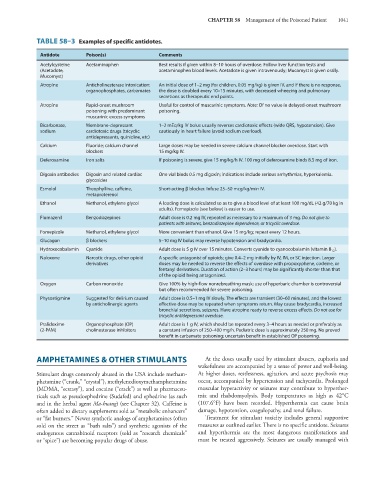Page 1055 - Basic _ Clinical Pharmacology ( PDFDrive )
P. 1055
CHAPTER 58 Management of the Poisoned Patient 1041
TABLE 58–3 Examples of specific antidotes.
Antidote Poison(s) Comments
Acetylcysteine Acetaminophen Best results if given within 8–10 hours of overdose. Follow liver function tests and
(Acetadote, acetaminophen blood levels. Acetadote is given intravenously; Mucomyst is given orally.
Mucomyst)
Atropine Anticholinesterase intoxication: An initial dose of 1–2 mg (for children, 0.05 mg/kg) is given IV, and if there is no response,
organophosphates, carbamates the dose is doubled every 10–15 minutes, with decreased wheezing and pulmonary
secretions as therapeutic end points.
Atropine Rapid-onset mushroom Useful for control of muscarinic symptoms. Note: Of no value in delayed-onset mushroom
poisoning with predominant poisoning.
muscarinic excess symptoms
Bicarbonate, Membrane-depressant 1–2 mEq/kg IV bolus usually reverses cardiotoxic effects (wide QRS, hypotension). Give
sodium cardiotoxic drugs (tricyclic cautiously in heart failure (avoid sodium overload).
antidepressants, quinidine, etc)
Calcium Fluoride; calcium channel Large doses may be needed in severe calcium channel blocker overdose. Start with
blockers 15 mg/kg IV.
Deferoxamine Iron salts If poisoning is severe, give 15 mg/kg/h IV. 100 mg of deferoxamine binds 8.5 mg of iron.
Digoxin antibodies Digoxin and related cardiac One vial binds 0.5 mg digoxin; indications include serious arrhythmias, hyperkalemia.
glycosides
Esmolol Theophylline, caffeine, Short-acting β blocker. Infuse 25–50 mcg/kg/min IV.
metaproterenol
Ethanol Methanol, ethylene glycol A loading dose is calculated so as to give a blood level of at least 100 mg/dL (42 g/70 kg in
adults). Fomepizole (see below) is easier to use.
Flumazenil Benzodiazepines Adult dose is 0.2 mg IV, repeated as necessary to a maximum of 3 mg. Do not give to
patients with seizures, benzodiazepine dependence, or tricyclic overdose.
Fomepizole Methanol, ethylene glycol More convenient than ethanol. Give 15 mg/kg; repeat every 12 hours.
Glucagon β blockers 5–10 mg IV bolus may reverse hypotension and bradycardia.
Hydroxocobalamin Cyanide Adult dose is 5 g IV over 15 minutes. Converts cyanide to cyanocobalamin (vitamin B 12 ).
Naloxone Narcotic drugs, other opioid A specific antagonist of opioids; give 0.4–2 mg initially by IV, IM, or SC injection. Larger
derivatives doses may be needed to reverse the effects of overdose with propoxyphene, codeine, or
fentanyl derivatives. Duration of action (2–3 hours) may be significantly shorter than that
of the opioid being antagonized.
Oxygen Carbon monoxide Give 100% by high-flow nonrebreathing mask; use of hyperbaric chamber is controversial
but often recommended for severe poisoning.
Physostigmine Suggested for delirium caused Adult dose is 0.5–1 mg IV slowly. The effects are transient (30–60 minutes), and the lowest
by anticholinergic agents effective dose may be repeated when symptoms return. May cause bradycardia, increased
bronchial secretions, seizures. Have atropine ready to reverse excess effects. Do not use for
tricyclic antidepressant overdose.
Pralidoxime Organophosphate (OP) Adult dose is 1 g IV, which should be repeated every 3–4 hours as needed or preferably as
(2-PAM) cholinesterase inhibitors a constant infusion of 250–400 mg/h. Pediatric dose is approximately 250 mg. No proved
benefit in carbamate poisoning; uncertain benefit in established OP poisoning.
AMPHETAMINES & OTHER STIMULANTS At the doses usually used by stimulant abusers, euphoria and
wakefulness are accompanied by a sense of power and well-being.
Stimulant drugs commonly abused in the USA include metham- At higher doses, restlessness, agitation, and acute psychosis may
phetamine (“crank,” “crystal”), methylenedioxymethamphetamine occur, accompanied by hypertension and tachycardia. Prolonged
(MDMA, “ecstasy”), and cocaine (“crack”) as well as pharmaceu- muscular hyperactivity or seizures may contribute to hyperther-
ticals such as pseudoephedrine (Sudafed) and ephedrine (as such mia and rhabdomyolysis. Body temperatures as high as 42°C
and in the herbal agent Ma-huang) (see Chapter 32). Caffeine is (107.6°F) have been recorded. Hyperthermia can cause brain
often added to dietary supplements sold as “metabolic enhancers” damage, hypotension, coagulopathy, and renal failure.
or “fat burners.” Newer synthetic analogs of amphetamines (often Treatment for stimulant toxicity includes general supportive
sold on the street as “bath salts”) and synthetic agonists of the measures as outlined earlier. There is no specific antidote. Seizures
endogenous cannabinoid receptors (sold as “research chemicals” and hyperthermia are the most dangerous manifestations and
or “spice”) are becoming popular drugs of abuse. must be treated aggressively. Seizures are usually managed with

